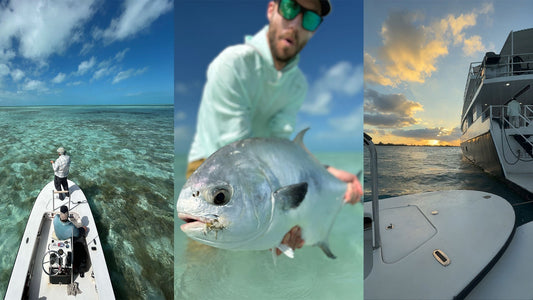All Points Fly Shop + Outfitter Blog

Trip Report: Turneffe Flats, Belize (April 12-1...
I recently returned from another hosted trip to one of the Caribbean’s most unique and diverse fisheries: Turneffe Flats on Turneffe Atoll, Belize. Whether or not it’s true that Peter...
Trip Report: Turneffe Flats, Belize (April 12-1...
I recently returned from another hosted trip to one of the Caribbean’s most unique and diverse fisheries: Turneffe Flats on Turneffe Atoll, Belize. Whether or not it’s true that Peter...

Trip Report: Cuba (January 25-February 1st, 2025)
Location: Canarreos Archipelago, Cuba The entire Miami airport was shutdown. We sat in our plane still at the apron, while about a quarter of the passengers were up at the...
Trip Report: Cuba (January 25-February 1st, 2025)
Location: Canarreos Archipelago, Cuba The entire Miami airport was shutdown. We sat in our plane still at the apron, while about a quarter of the passengers were up at the...

Video: Fly Tying - Shrouser
You've heard of the Crouser, now here is how to tie the Shrouser. A shrimp hybrid of the Crouser, this pattern has found great success chasing bonefish and permit on...
Video: Fly Tying - Shrouser
You've heard of the Crouser, now here is how to tie the Shrouser. A shrimp hybrid of the Crouser, this pattern has found great success chasing bonefish and permit on...

Ask the Guide: Best Flies for Cuba
Words + Photos by: Josh Thelin On a recent trip to Cuba, after a week of fishing, I asked my guide Frankie what his favorite flies were for the areas...
Ask the Guide: Best Flies for Cuba
Words + Photos by: Josh Thelin On a recent trip to Cuba, after a week of fishing, I asked my guide Frankie what his favorite flies were for the areas...

Trip Report: Cuba (January 6-13th, 2024)
Words + Photos: Josh Thelin I didn't know what to expect. It was not only my first time in Cuba, but I had heard so much about the flats fishing and...
Trip Report: Cuba (January 6-13th, 2024)
Words + Photos: Josh Thelin I didn't know what to expect. It was not only my first time in Cuba, but I had heard so much about the flats fishing and...

Video: Fly Tying - Crouser for Bonefish & Permit
By now you have likely seen or heard about the Original Crouser fly that Joe Webster ties here at All Points. As this is a pattern that is most commonly...
Video: Fly Tying - Crouser for Bonefish & Permit
By now you have likely seen or heard about the Original Crouser fly that Joe Webster ties here at All Points. As this is a pattern that is most commonly...